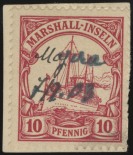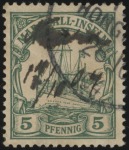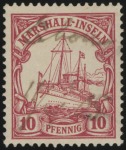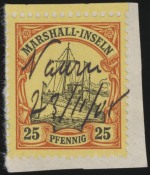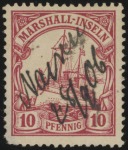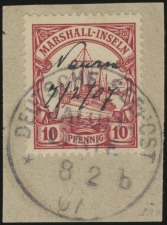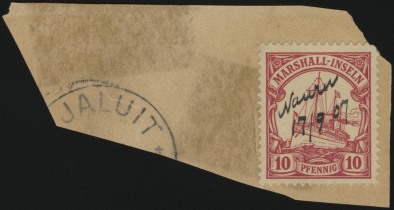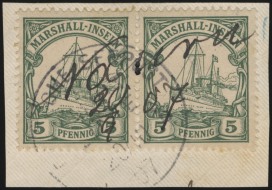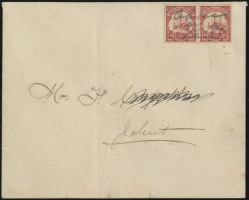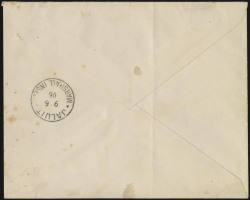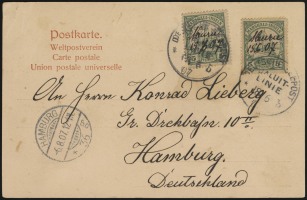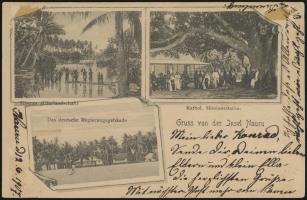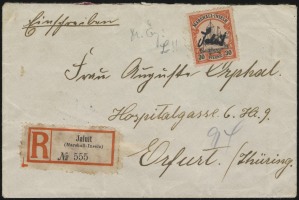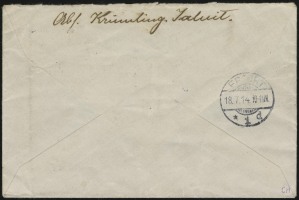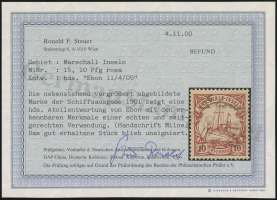Atoll Post
Upon the opening of the Jaluit post office in March 1889, the government issued an order that ships traveling between the atolls of Marshall-Inseln were to take-on mail, as there was no other scheduled service to the scattered atolls.
Subsequent directives in 1902 and 1903 would further specify procedures for receiving and cancelling these “atoll post” items. In general, most received manuscript cancellations with the date of receipt and the name of the ship or name of the atoll.
Atoll post items dated to 1907 are generally considered legitimate. Beginning in 1908, philatelic interest led to widespread creation of philatelic items, particularly those cancelled on-board the Diana and Eanijen Rakijen. Legitimate uses are known from at least 19 atolls.
Despite most Atoll Post items from 1908 forward being philatelic forgeries, Dr. Eduard Ey, in his master work Die Briefmarken der deutschen Postanstalten im Auslande und der deutschen Schutzgebiete, noted that the legitimate Atoll Post items again appeared at the beginning of World War I, with several items known to have been properly transported through the postal system.
This cover originated on Jaluit, presumably in the summer of 1914. It has no date, but it bears a receiving mark from Erfurt, Germany, dated 18 July 1914, indicating that it did properly pass through the postal system.
The manuscript “Jaluit” on the stamp is in the handwriting of the Capt Julius Krümling. Capt Krümling was, from 1 Oct 1904 until WWI, the postmaster, harbor master, constable, and customs officer in Jaluit, and also a ship’s pilot within the Marshall Islands. He was not known to have participated in the forgery of Atoll Post items, and his handwriting and “Jaluit” manuscript cancel are well known. This would seem to indicate it was he who cancelled the stamp, lending credibility to the authenticity of this item.
The sender indicated on the reverse of the cover is “Krümling, Jaluit.” This would seem to indicate that he wasn’t merely cancelling a stamp that was missed by the canceller, but that it was he himself who posted and cancelled the letter.
Atoll Post
Upon the opening of the Jaluit post office in March 1889, the government issued an order that ships traveling between the atolls of Marshall-Inseln were to take-on mail, as there was no other scheduled service to the scattered atolls.
Subsequent directives in 1902 and 1903 would further specify procedures for receiving and cancelling these “atoll post” items. In general, most received manuscript cancellations with the date of receipt and the name of the ship or name of the atoll.
Atoll post items dated to 1907 are generally considered legitimate. Beginning in 1908, philatelic interest led to widespread creation of philatelic items, particularly those cancelled on-board the Diana and Eanijen Rakijen. Legitimate uses are known from at least 19 atolls.
Despite most Atoll Post items from 1908 forward being philatelic forgeries, Dr. Eduard Ey, in his master work Die Briefmarken der deutschen Postanstalten im Auslande und der deutschen Schutzgebiete, noted that the legitimate Atoll Post items again appeared at the beginning of World War I, with several items known to have been properly transported through the postal system.
This cover originated on Jaluit, presumably in the summer of 1914. It has no date, but it bears a receiving mark from Erfurt, Germany, dated 18 July 1914, indicating that it did properly pass through the postal system.
The manuscript “Jaluit” on the stamp is in the handwriting of the Capt Julius Krümling. Capt Krümling was, from 1 Oct 1904 until WWI, the postmaster, harbor master, constable, and customs officer in Jaluit, and also a ship’s pilot within the Marshall Islands. He was not known to have participated in the forgery of Atoll Post items, and his handwriting and “Jaluit” manuscript cancel are well known. This would seem to indicate it was he who cancelled the stamp, lending credibility to the authenticity of this item.
The sender indicated on the reverse of the cover is “Krümling, Jaluit.” This would seem to indicate that he wasn’t merely cancelling a stamp that was missed by the canceller, but that it was he himself who posted and cancelled the letter.
Album Page(s)
Certificate(s)

